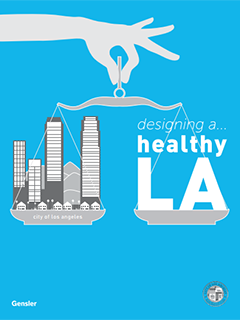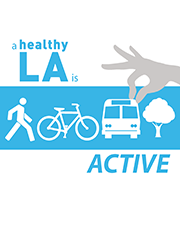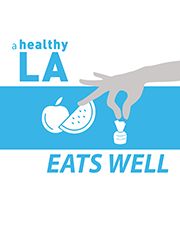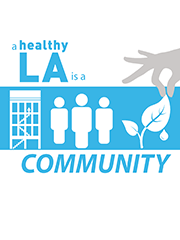Chapter 1: A Healthy LA is Active
Places and spaces encouraging people to incorporate physical activity into daily routines is fundamental to the creation of a healthy L.A.. Designing a Healthy LA requires a shift from single-passenger vehicles to multiple modes of mobility, including rail, bus, bikes, and walking. Transit is considered an active form of transportation as users often walk to and from transit stops, completing the “last mile”. A system of walking and bicycling paths and multi-modal transit options encourage and allows for increased movement, independent of the car, throughout Los Angeles and increases the vibrancy of the City and the health of its residents. In addition to personal and mass transit options, increased access to varied forms of open space is also shown to increase levels of activity, leading to improved health outcomes. Los Angeles’ varied neighborhoods need to accommodate diverse users and activities with a range of scales and types of open spaces, encouraging physical activity for people of all ages and abilities.
- Walkability
- Bikeability
- Active transit
- Public open space
Chapter 2: A Healthy LA Eats Well
Types, amount, and availability of healthy food is just as important in promoting healthier lifestyles and combating chronic disease as is increased physical activity. Currently, there simply are not enough healthy food outlets and places growing and selling nutritious foods to serve the varied neighborhoods of Los Angeles. Providing locally produced, nutritious foods positively impacts personal health and well-being. Urban gardens can provide broader advantages - boosting the local economy and improving communities by bettering environmental quality. Cultivating and consuming locally grown food can ensure a high level of food quality, take advantage of L.A.’s climatic advantages and reinforce healthy eating behaviors.
- Locally produced food
- Access to nutritious food
Chapter 3: A Healthy LA is a Community
A healthy community includes equitable access to education, housing, jobs, the ability to live without fear of violence, freedom from environmental hazards, and a meaningful built environment. The design of our communities is critical to the health of Los Angelenos, both their physical and mental well-being. Building design can easily promote a more active lifestyle. The organization of a building and the visibility of stairs are a simple way to increase daily physical activity. Embracing universal design increases accessibility for all people, with and without disabilities. Placemaking is at the heart of a community and critical to individual stability and well-being. A well designed urban environment can elevate our quality of life and result in a cleaner, more active, and socially connected Los Angeles.
- Social capital
- Clean environment
- Built environment



